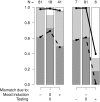Mood As Cumulative Expectation Mismatch: A Test of Theory Based on Data from Non-verbal Cognitive Bias Tests
- PMID: 29491844
- PMCID: PMC5824615
- DOI: 10.3389/fpsyg.2017.02197
Mood As Cumulative Expectation Mismatch: A Test of Theory Based on Data from Non-verbal Cognitive Bias Tests
Abstract
Affective states are known to influence behavior and cognitive processes. To assess mood (moderately long-term affective states), the cognitive judgment bias test was developed and has been widely used in various animal species. However, little is known about how mood changes, how mood can be experimentally manipulated, and how mood then feeds back into cognitive judgment. A recent theory argues that mood reflects the cumulative impact of differences between obtained outcomes and expectations. Here expectations refer to an established context. Situations in which an established context fails to match an outcome are then perceived as mismatches of expectation and outcome. We take advantage of the large number of studies published on non-verbal cognitive bias tests in recent years (95 studies with a total of 162 independent tests) to test whether cumulative mismatch could indeed have led to the observed mood changes. Based on a criteria list, we assessed whether mismatch had occurred with the experimental procedure used to induce mood (mood induction mismatch), or in the context of the non-verbal cognitive bias procedure (testing mismatch). For the mood induction mismatch, we scored the mismatch between the subjects' potential expectations and the manipulations conducted for inducing mood whereas, for the testing mismatch, we scored mismatches that may have occurred during the actual testing. We then investigated whether these two types of mismatch can predict the actual outcome of the cognitive bias study. The present evaluation shows that mood induction mismatch cannot well predict the success of a cognitive bias test. On the other hand, testing mismatch can modulate or even inverse the expected outcome. We think, cognitive bias studies should more specifically aim at creating expectation mismatch while inducing mood states to test the cumulative mismatch theory more properly. Furthermore, testing mismatch should be avoided as much as possible because it can reverse the affective state of animals as measured in a cognitive judgment bias paradigm.
Keywords: affective states; animal welfare; cognitive bias; judgment bias; mood.
Figures

Similar articles
-
Frontal brain deactivation during a non-verbal cognitive judgement bias test in sheep.Brain Cogn. 2015 Feb;93:35-41. doi: 10.1016/j.bandc.2014.11.004. Epub 2014 Dec 12. Brain Cogn. 2015. PMID: 25506630
-
Use of cognitive bias as a welfare tool in poultry.J Anim Sci. 2020 Aug 18;98(Supplement_1):S63-S79. doi: 10.1093/jas/skaa039. J Anim Sci. 2020. PMID: 32016360 Free PMC article. Review.
-
Negative expectations and vulnerability to stressors in animals.Neurosci Biobehav Rev. 2021 Nov;130:240-251. doi: 10.1016/j.neubiorev.2021.08.025. Epub 2021 Aug 26. Neurosci Biobehav Rev. 2021. PMID: 34454913 Review.
-
Cognitive tasks as measures of pig welfare: a systematic review.Front Vet Sci. 2023 Nov 13;10:1251070. doi: 10.3389/fvets.2023.1251070. eCollection 2023. Front Vet Sci. 2023. PMID: 38033647 Free PMC article.
-
Bottlenose dolphins engaging in more social affiliative behaviour judge ambiguous cues more optimistically.Behav Brain Res. 2017 Mar 30;322(Pt A):115-122. doi: 10.1016/j.bbr.2017.01.026. Epub 2017 Jan 18. Behav Brain Res. 2017. PMID: 28110003
Cited by
-
Structural environmental enrichment and the way it is offered influence cognitive judgement bias and anxiety-like behaviours in zebrafish.Anim Cogn. 2023 Mar;26(2):563-577. doi: 10.1007/s10071-022-01700-x. Epub 2022 Oct 9. Anim Cogn. 2023. PMID: 36209454
-
Mood induction alters attention toward negative-positive stimulus pairs in sheep.Sci Rep. 2019 May 23;9(1):7759. doi: 10.1038/s41598-019-44330-z. Sci Rep. 2019. PMID: 31123314 Free PMC article.
-
Using judgment bias test in pet and shelter dogs (Canis familiaris): Methodological and statistical caveats.PLoS One. 2020 Oct 27;15(10):e0241344. doi: 10.1371/journal.pone.0241344. eCollection 2020. PLoS One. 2020. PMID: 33108399 Free PMC article.
-
Acceptance Mindfulness-Trait as a Protective Factor for Post-Natal Depression: A Preliminary Research.Int J Environ Res Public Health. 2022 Jan 29;19(3):1545. doi: 10.3390/ijerph19031545. Int J Environ Res Public Health. 2022. PMID: 35162565 Free PMC article.
-
Once an optimist, always an optimist? Studying cognitive judgment bias in mice.Behav Ecol. 2022 Jun 3;33(4):775-788. doi: 10.1093/beheco/arac040. eCollection 2022 Jul-Aug. Behav Ecol. 2022. PMID: 35812364 Free PMC article.
References
-
- Baciadonna L., McElligott A. G. (2015). The use of judgement bias to assess welfare in farm livestock. Anim. Welf. 24 81–91. 10.7120/09627286.24.1.081 - DOI
-
- Barker T. H., Howarth G. S., Whittaker A. L. (2016). The effects of metabolic cage housing and sex on cognitive bias expression in rats. Appl. Anim. Behav. Sci. 177 70–76. 10.1016/j.applanim.2016.01.018 - DOI
-
- Bateson M., Matheson S. M. (2007). Performance on a categorisation task suggests that removal of environmental enrichment induces ‘pessimism’ in captive European starlings (Sturnus vulgaris). Anim. Welf. 16(Suppl.), 33–36.
LinkOut - more resources
Full Text Sources
Other Literature Sources
Research Materials

